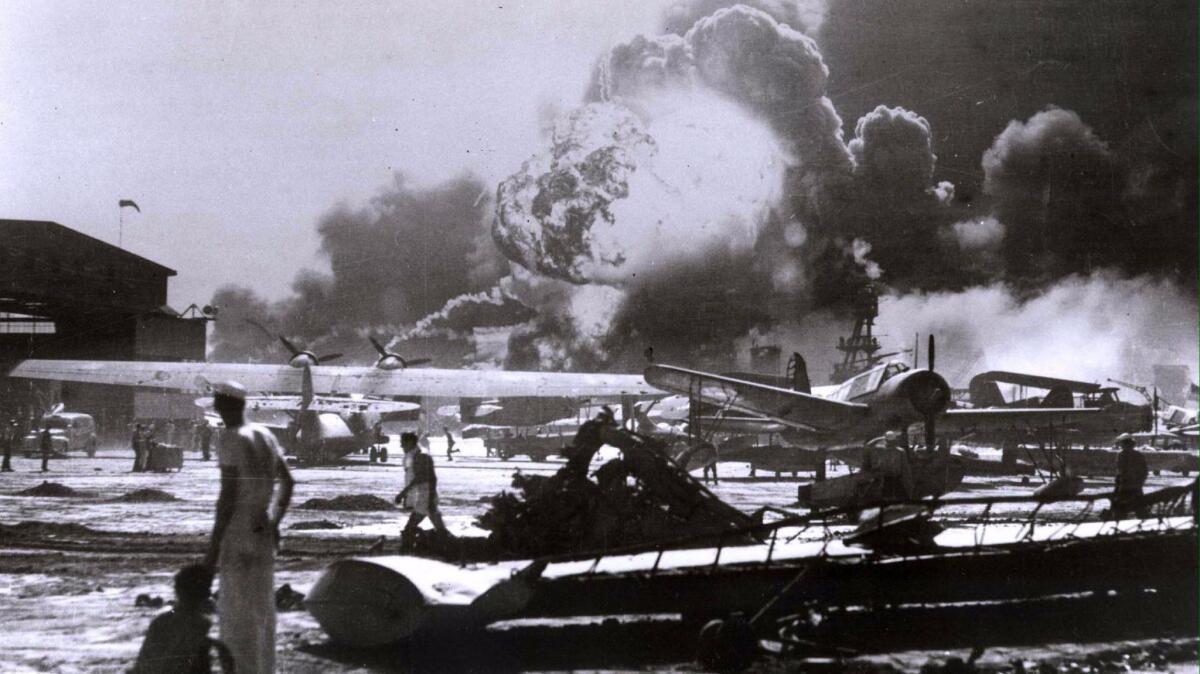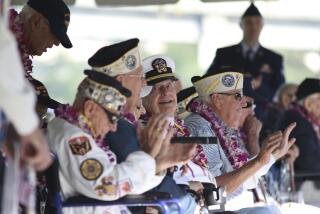The U.S. military expected a Japanese attack in 1941 - but not in Hawaii, explains ‘Countdown to Pearl Harbor’

Reporting from Washington — As Hollywood regularly reminds us, the Japanese attack on Pearl Harbor in Hawaii on Dec. 7, 1941, was an act of duplicity so monstrous that President Franklin D. Roosevelt called it a “date which will live in infamy.”
Japanese warplanes appeared without warning early that Sunday, sinking or disabling 16 U.S. battleships, cruisers and other warships. The sneak attack killed more than 2,400 Americans and forced the reluctant nation into the caldron of World War II.
But the iconic images and stirring oratory largely overshadowed disturbing questions of culpability. Why was the Navy’s Pacific Fleet caught at anchor? Why did the Army provide no defense? And was the attack really a surprise?
Nine official inquiries during and after the war sought answers, and historians, survivors and conspiracy theorists have weighed in ever since. In the 1990s, new details emerged about the secret interception of pre-war Japanese diplomatic cables, raising fresh questions of how much Washington knew.
In “Countdown to Pearl Harbor: The Twelve Days to the Attack,” Steve Twomey, who was a Pulitzer prize-winning feature writer at the Philadelphia Inquirer, has mined the copious testimony, memoirs, oral histories and other evidence to produce a riveting narrative of the American misjudgments and mistakes that contributed to a day rivaled in U.S. history only by Sept. 11, 2001.
It’s not revisionist history so much as a poignant retelling of a familiar story: gross negligence by Navy and Army commanders in Hawaii, multiple miscommunications from top officials in Washington, and agonizing failures of American leadership and imagination.
Their adversary, primarily Japanese Admiral Isoroku Yamamoto, had both.
An inveterate gambler, he bet he could lead six aircraft carriers and two dozen other warships halfway across the Pacific — despite the dangers of discovery and difficulties of mid-ocean refueling — to deliver a knockout blow at the start of the war. He almost succeeded.
No one had ever massed aircraft carriers for a coordinated attack. But the Imperial Navy had understood the carriers’ value, building ten by the end of 1941. The U.S. Navy, still wedded to archaic battleships, had only three carriers in the Pacific.
The Navy saw Pearl Harbor as a refuge. The Japanese saw it as a bulls-eye, “a barrel crammed with fish, tied up and stationary, without room to maneuver and only one way out, a narrow channel that was susceptible to blockage.”
There was plenty of blame to go around but Twomey wisely focuses on a handful of key Americans. He writes sympathetically of their struggles to understand the growing danger. They were overconfident, not complacent, too quick to dismiss Japan’s military as second-rate and blind to the threat of modern aircraft armed with torpedoes.
Admiral Husband E. Kimmel, who had spent four decades in the Navy and was commander of the Pacific Fleet at Pearl, was a respected by-the-book leader. “Laxness, lateness and subpar performance were felonies as far as Kimmel was concerned,” Twomey writes.
The Admiral believed war with Japan was inevitable. So did Roosevelt. The president had moved the fleet to Hawaii in 1940 precisely because he expected war in the Pacific and didn’t want it fought off the coast of California.
Washington was secretly reading Japanese diplomatic cables in 1941 so top officials knew when its embassies were ordered to burn code books and other sensitive material. U.S. Army and Navy chiefs repeatedly warned Kimmel and other commanders in the Pacific that an attack was coming. Where and when was never clear.
Ten days before Pearl Harbor, the chiefs ordered an “appropriate defensive deployment” in a terse cable that dramatically began, “This dispatch is to be considered a war warning.” The alarm couldn’t have been more clear — or less specific.
The warning didn’t mention Hawaii. And Kimmel could not conceive of a Japanese raid on Pearl Harbor.
His fleet couldn’t sail all the way to Japan in secret, launch a major attack and get away. If he couldn’t do it, he reasoned, neither could the Japanese.
Thus he took no precautions to guard the fleet at anchor.
He ordered no submarine or torpedo nets, no blimps over the ships with cables to tangle aircraft, no 24-hour radar net, no search planes on offshore patrol, no crews manning anti-aircraft guns, no orders for the Arizona and other doomed warships to leave the crowded harbor, no heightened alerts at all.
In Washington, the chiefs assumed — but never checked — that he had moved the armada out of danger and had readied a defense.
Kimmel’s Army counterpart in Hawaii, Lt. Gen. Walter C. Short, known as “Machine Gun Short,” was just as short-sighted. His concern was local sabotage, not an air attack from ships. He and Kimmel barely communicated; their separate headquarters didn’t even have a direct phone line.
Each thought the other was in charge of defending Oahu. Thus neither was prepared when 350 Japanese planes roared out of the rising sun, carrying out a mission that neither thought was possible.
The damage was not as severe as Yamamoto had hoped. His pilots inexplicably failed to hit fuel oil tank farms near the harbor or the dry docks needed to repair the stricken ships. The Navy would soon recover.
More importantly, by chance Kimmel had sent his carriers to deliver fighter planes to Midway and Wake several days earlier. The Enterprise and Lexington later would prove invaluable at the crucial battles of Midway and Coral Sea.
Kimmel and Short were relieved from command after the attack. A commission led by the chief justice of the Supreme Court found they had “failed to consult and cooperate,” which was a “dereliction of duty.” But with the war underway, neither was given a court martial.
Despite repetitions, Twomey manages to maintain suspense as the tragedy builds to its inevitable finale. He disappoints only by devoting so little — six pages total — to the attack itself. For that, there’s always Hollywood.
ALSO
Books on the Pearl Harbor attack and its aftermath for kids and teens
Publishers are reeling from Trump’s win, but the news is not all bad
More to Read
Sign up for our Book Club newsletter
Get the latest news, events and more from the Los Angeles Times Book Club, and help us get L.A. reading and talking.
You may occasionally receive promotional content from the Los Angeles Times.







